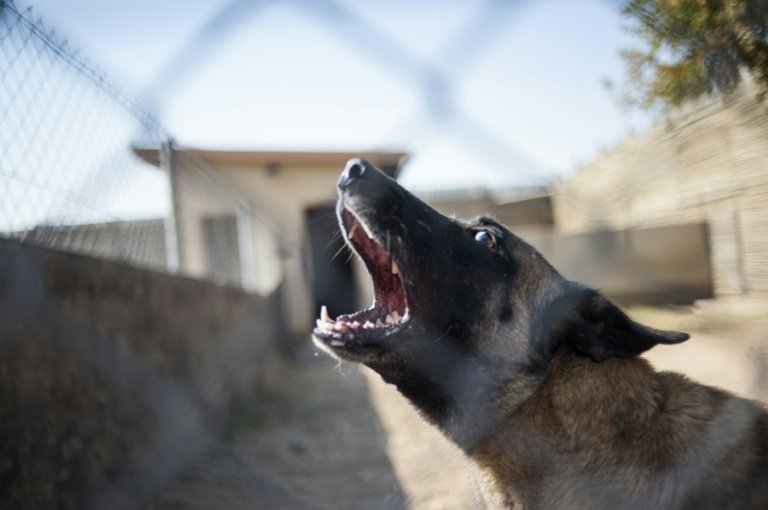
Barking and snarling in his cage, “Killer” — South Africa’s most successful poacher-catching canine — looks ready for another helicopter mission tracking down armed hunters who slaughter rhinos for their horns.
In the first half of this year, Killer has already helped rangers arrest more than 15 poachers in the Kruger National Park as authorities try in vain to stem a rapid rise in the number of rhino being killed.
Chosen for his focus and ferocity, the six-year-old jet black and tawny brown Belgian Malinois is the champion of the four-legged stars serving on the front lines of the vicious anti-poaching war.
“He’s had very good success so far, he’s very good on human scent tracking,” Johan de Beer, kennel master at the Kruger canine unit, told AFP.
De Beer, a barrel-chested man with a salt and pepper goatee, said that despite his name Killer is a gentle dog who is great at his job.
“He bites, but we don’t use him that much to bite,” said De Beer. “He’s actually a very placid dog. He likes riding in a chopper, stuff like that, he’s quite adventurous.”
Since 2007, rhino poaching has risen rapidly every year in the Kruger as animals are killed for their horn, used for its supposed medicinal qualities in China, Vietnam and Thailand.
In 2014, a record 1,215 rhino were killed and that number is set to be exceeded this year.
– A tough battle –
Amid the carnage, the Kruger canine programme has been a rare bit of good news thanks to dogs like Killer and Gladys, a lively Springer Spaniel who sniffs out guns and ammunition at park gates.
Kruger authorities now plan to boost the number of dogs from 29 to more than 40 by the end of the year.
“The dogs are contributing a huge success to catching poachers,” said De Beer, adding that the hunters — who are often trained gunmen from bordering Mozambique — have adapted their strategies to try to evade capture.
“They got clever, they dropped chillies (chilli peppers) on the trail, but it didn’t work, the dogs still found them,” he said laughing.
Yet a dog is only as good as his handler — and it is the special bond between Killer and his handler Amos Mzimba that sets them apart.
“We make a good team because of our mutual understanding of each other, our companionship,” said Mzimba, who practises drills with Killer every day, rewarding him by playing ball games.
A typical assignment sees Killer and Amos rushing by helicopter to wherever a poacher has been spotted or a rhino carcass discovered, and then tracking the suspect through the bush for as far as eight kilometres (five miles).
For those who knew Killer as a puppy, his fame does not come as a surprise.
“He was a very active, mobile puppy,” said Killer’s breeder, Henry Holsthyzen, of the Paramount Anti-Poaching and K9 Academy outside Johannesburg.
“That whole litter was just phenomenal, they had high drive, they had a natural ability to track, they had aggression.
“It was natural to pair them with the Kruger.”
– Bred for success –
The Belgian Malinois is used by military, police and private security organisations around the world, including US special forces.
In 2011, a Belgian Malinois named Cairo was used in the operation to capture and kill Osama bin Laden.
This year, the breed has also enjoyed some stardom on the silver screen in “Max”, a movie about a dog deployed in Afghanistan.
Holsthyzen, 43, who used to work with the South African police, recognised the breed would be well suited for anti-poaching work, which requires fearless dogs who can withstand the scorching temperatures of the African bush.
Killer was trained for 16 months before being sent to the Kruger aged 18 months to learn how to identify scents, to follow mock trails and to attack.
In spite of the dangers from armed poachers and poisonous snakes, Holsthyzen said he was proud that his dogs were playing their part in Kruger’s battle to save its rhinos.
“I see those dogs as my babies, especially Killer and those litters, I’ve raised them personally,” said Holsthyzen. “He’s contributing to society.”
